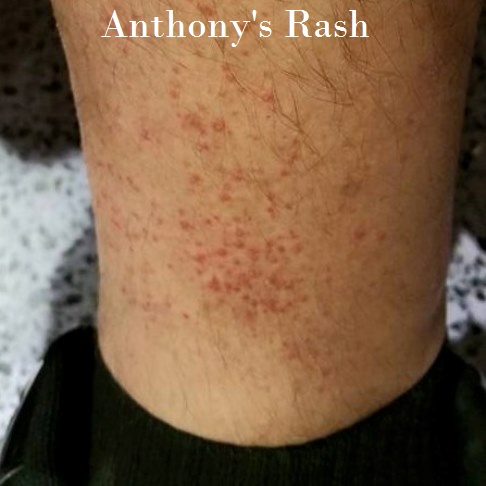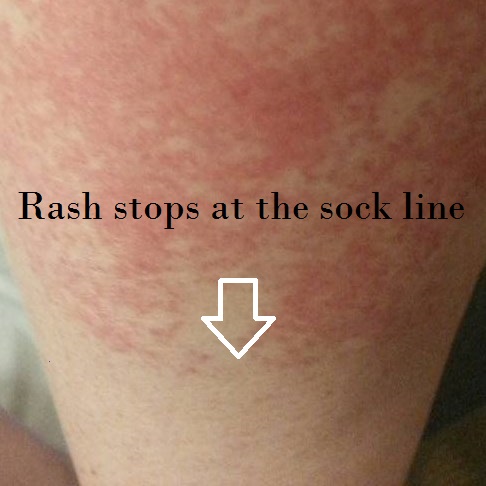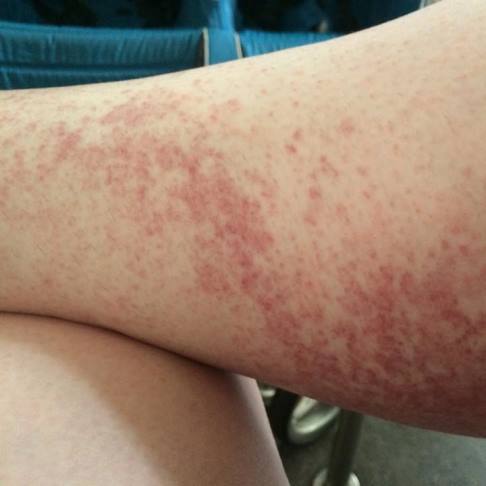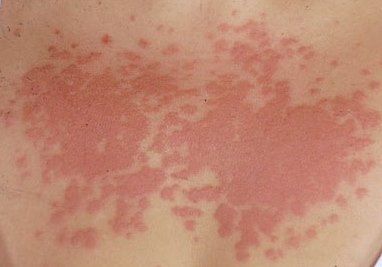The Disney Rash
Have you ever gotten a rash at Disney World and wondered what it was? When Anthony posted a picture on Facebook group, asking about a rash he got on his ankles and calves at Disney World, he got all kinds of suggestions guaranteed to induce panic: sand fleas, chiggers, splash from herbicides, scabies, bedbugs, virus, and flesh eating bacteria, to name a few. The good news is that he didn’t have any of those things and you probably don’t need to worry about those things either. We’ve highlighted a few of the most common rashes people get on their ankles and legs while walking around in the theme parks; this article doesn’t include food related issues or allergic reactions to detergents used on hotel linens.
We hope you find this information helpful but please keep in mind that we are not doctors and this article should not replace qualified medical advice. Definitely seek medical attention if you have a rash that is accompanied by dizziness, fainting, chest pain, or other serious symptoms. Remember too that rashes can become infected and may need medical intervention. There is a first aid station at every Disney World park and the managers of the Disney World hotels can also help arrange for medical attention. Many health insurance cards include an “Ask a Nurse” phone number that can be helpful when you have a question while on vacation.
Exercise-Induced Vasculitis (EIV) - Rash on Ankles and Lower Legs
Let’s start planning a great vacation!
We want to help you have the most wonderful, most memorable Disney vacation possible. We know that giving you good, up-to-date information and a few simple tools will make a huge difference in your Disney vacation. Long lines become shorter lines and you will have great memories of shared experiences instead of missed opportunities. There’s never any pressure or obligation and there is no extra charge when you book through us.
One of the most common rashes reported from Disney guests is Exercise-Induced Vasculitis (EIV) and is what most people experience when they talk about the Disney rash or the Epcot rash. EIV is also commonly called Golfer’s Vasculitis because the doctor who published an early study on the condition started investigating it as a result of patients who complained of developing a rash on their lower legs and ankles while playing golf. In a nutshell, a person’s legs and ankles begin to swell (this is called edema) due to standing and walking in a hot and humid location; the swelling inflames the small blood vessels in the cells and causes red bumps to appear on the surface of the skin. This particular rash can be itchy; in my case, it kind of feels like you’ve wrapped one of those mesh bags that oranges or onions come in tightly around the skin and then it swelled through the mesh while it is developing and then the itch starts later. The combination of reflected light and heat from walking surfaces along with direct sunlight seem to be a factor, which is why the rash typically occurs on the ankles and lower calves. My mom and I get this rash at Epcot but I’ve also gotten it in the ruins of Ephesus (Turkey) and on a New York City walking tour. Because the rash typically occurs above the sock line, it often gets misdiagnosed as an allergen, bug bite or other irritant that came in contact with the exposed skin but swabs of the skin surface typically come back as negative. The reason that the rash doesn’t occur below the sock line is that the sock and shoe provide compression that reduces edema and prevents damage to small blood vessels. This type of rash is not contagious and typically goes away in about a week.
How to avoid Exercise-Induced Vasculitis (EIV):
Get walking! One of best things you can do is to begin regularly walking in the months prior to your trip; this will increase your stamina and you’ll enjoy the whole vacation more. People typically walk 5 – 11 miles over the course of a full day in the theme parks.
Drink Plenty of Water - It may seem counter-intuitive but drinking water will help reduce swelling. People sometimes decrease their water consumption in the parks because of the cost of bottled water and because Florida tap water has a strong taste - my kids call it “alligator armpit water”. You can get a free cup of filtered ice water at any Disney quick-service restaurant. Bringing cases of bottled water or having it delivered to your resort (click here for more information) can save money and help you to make sure everyone has water available when they start the day and when you are at your hotel. Disney will let you take bottled water into the park but Universal sometimes restricts this. If you carry your own reusable water bottle, your server may be willing to refill it at the restaurant. Be careful about the consumption of salty foods and soft drinks that will lead to water retention and contribute to edema.
Elevate your feet – Once swelling begins, you may be able to decrease it by raising your feet above your heart. At your resort, you can lay on your bed with your feet elevated on a pillows, a bag or even the wall for about 30 minutes. It is a little trickier in the parks but you can go to the First Aid station or lay on a park bench and rest your feet on the arm rest.
Take Ibuprofen (Advil, Motrin) at the beginning of the day - In this case, you’re taking ibuprofen, which has anti-inflammatory properties, to prevent or reduce swelling rather than as a response to pain so take it in the morning, before you start walking in the parks. I usually just take a full dose in the morning but others recommend repeating the dose throughout the day, per package instructions. Every medication has side effects so check with your doctor about any cautions relating to your health.
Wear Socks – Wearing taller socks or even compression socks will cover the skin and restrict swelling.
Cool the affected area – Cover affected areas with wet towels, get in the swimming pool, or even rub an ice cube over the area, if you’re still in the parks.
Alternate your Activities – Look for things like shows, longer rides, and 3D movies that get you off of your feet and out of the sun in the theme parks. You may also want to take a mid-day break or swim back at your resort.
My Experience - We bought some Coppertone aerosol spray sunscreen in the gift shop of our Disney hotel and, after a day in the parks, I could see where I'd sprayed and where I had missed because the areas that were sprayed did not have the bumps to nearly the degree as the areas I missed. After that, I was very careful about applying the spray sunscreen on ankles and lower legs and I really do believe it helps.
What to Do If You Already Have the Rash
Follow the above steps for reducing swelling – Keep your rash from getting worse by following the above steps, especially if you have more days in the theme parks.
Use a topical anti-itch ointment. They can give you an ointment at the first aid stands in the park or you can purchase an over-the-counter variety in a pharmacy. Some people swear by those blue, aloe “after burn” gels available in drug stores; others recommend calamine lotion.
Consult a doctor if you get worse or if the rash doesn’t begin clearing on its own in about a week, sooner if your symptoms change for the worse.
Prickly heat rash - Rash in folds of skin or areas covered by clothing
Heat rash (miliaria) is very common among Disney World visitors, especially during hot and humid seasons. The name tells it all – a rash that is the result of heat. These rashes usually appear in the folds of skin and areas that are covered by clothing because of friction and because air cannot circulate and evaporate sweat. This rash forms when sweat glands clog, forcing sweat to remain under the surface of the skin. This can cause skin to redden along with raised bumps and even small, liquid filled blisters. Infants are especially prone to heat rashes and thick, heavy sun screens that block the pores can also contribute to heat rash. Heat rash is can also be a problem for people using scooters in the areas where their bodies are pressed against the seat. The great thing is that heat rash typically resolves on its own when skin cools down though medical attention may be required if the blocked sweat ducts become infected.
How to avoid heat rash
Avoid tight clothes and fabrics that don’t “breathe” when you know you’ll be in a hot and humid environment.
Alternate Indoor and Outdoor Attractions – Make sure you go into air conditioned attractions when during the heat of the day to keep from getting too hot.
Make sure you drink enough water to stay hydrated.
Rash on uncovered areas of skin exposed to sunlight – Polymorphous Light Eruption (PMLE)
Some people will develop a rash on skin that is exposed to sunlight and that is not subject to friction from other skin or clothes. This is a photosensitivity or mild allergic reaction to sunlight called Polymorphic Light Eruption (PMLE) that is different than a sunburn and it can vary a bit in appearance, including redness, raised rough patches of skin, and dense clusters of small bumps that can be itchy. It can appear within minutes or as late as two hour after exposure and is most common in the spring and early summer when body parts that have been covered all winter are first exposed to the light of day. PMLE affects 10% - 15% of the population of the United States and seems to be more common in people of northern European ancestry and people with fair skin. In most cases, it will clear up on its own but you should seek medical attention if the rash is accompanied by a fever or pain.
How to avoid PMLE
Incidents often decrease with exposure – For whatever reason, this particular rash most commonly occurs when skin that has not been exposed to sunlight for long periods is exposed the first or second time, triggering an immune-system reaction. The body seems to adjust with time so try to expose your skin to direct sunlight for short periods before heading to Florida. I’m not advocating getting a sunburn here, just get enough sunlight in multiple short increments to the point that you’re no longer quite so wintery pale.
What to Do If You Already Have the Rash
Cover up! Since this is a reaction to sunlight, the best thing you can do is to cover the skin as soon as you notice a reaction. Light, gauzy clothing and a wide brimmed hat can be good summertime choices. High SPF sunscreen doesn’t seem to help with this particular reaction though it may still be a good idea for uncovered areas because you sure don’t need a sunburn on top of an itchy rash.
Avoid direct sunlight – Try to maximize indoor and shaded attractions and activities between 10AM – 3PM so that you are not exposed to direct sunlight at its peak.
Oral antihistamines and topical anti-itch cortisone creams can help alleviate itching and irritation.
Some Other Reasons People Get Rashes
There are other things that can cause rashes, for example, Angela shared this picture with us of a rash she gets, called Leukocytoclasic Vasculitis (LCV), that happens as a result of a rare blood disorder but looks a lot like common exercise-induced vasculitis. She’s under doctor’s care and knows to anticipate it.
Some medications, including certain antibiotics, can cause sun related issues. You can ask your pharmacist if any of your medications have sun sensitizing side effects or click here to learn more.
If this article was helpful, you may want to subscribe to our free newsletter that covers a wide range of topics related to planning a Disney vacation. We send out about three email newsletters per month. We respect your privacy and will never share your information; you can easily unsubscribe at any time. You can use the form below or click here for more information.
I would like to give a big thank you to Angela Ketchersid, C. Huntoon, Sharon McGehee, Brittney Scheidegger, and Anthony John for letting me use your Disney rash photos in this article. You were all so very helpful to me and I know your experience will be helpful to others too.
Don't Miss Out on Great Experiences at Disney World!
We want to help you have the most wonderful, most memorable Disney vacation possible. We know that giving you good, up-to-date information and a few simple tools will make a huge difference in your Disney vacation. Long lines become short lines and you will have great memories of shared experiences instead of missed opportunities. That's why we're called Build A Better Mouse Trip.
Here’s how we help you have a great vacation:
Your travel agent – You have one agent from start-to-finish who knows your name and your priorities and who wants to do everything possible to help you have a wonderful experience.
“Best Days” Vacation Planning – We’ll help you pick the best park for each day based on hours and expected crowd levels then we help with dining reservations and understanding which Disney Genie+ and individual Lightning Lane selections might be right for you.
Saving Money – Of course we watch for discounts and promotion and automatically apply the best available offer to your reservation but we also help you avoid up-sells and options you won’t use.
We Are Fee-Free - We book directly through Disney and we never charge a service fee so you never pay any extra to use our services when you book your trip through us. You can have all the benefits Disney offers PLUS all the services we offer.







